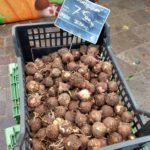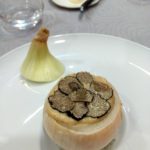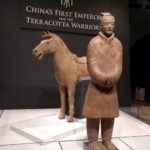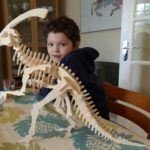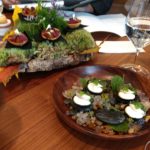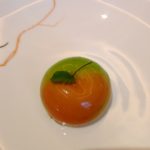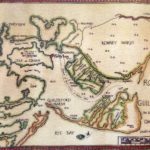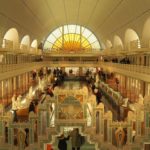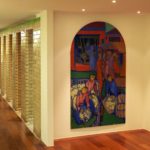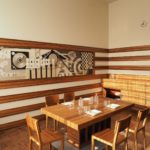To download a printable PDF version (no pictures)
click on this link E2E2018no5.pdf (six A4 pages)
There are links to our photographs of places and restaurants in the text
December opened in a festive mood for us on December 1st when we decided to drive over the hills to one of our favourite Christmas Markets at Barr in Alsace. This involved studying real-time maps to see where the gilets jaunes protesters in their high visibility yellow safety jackets were blockading roads and roundabouts in protest against increased fuel taxes (and later against other policies as well). But with coaches taking some of the protesters to Paris that day, the usual local trouble spots were quiet, and we had a lovely drive through tastefully decorated villages, past hillside plantations where people were stopping to purchase and load their Christmas tree, to slopes of vineyards, their leaves golden in rare rays of sunshine. And somewhere there must have been rain, as there was a rainbow arch.
In Barr we parked near the Saturday food market which was guarded by two police who seemed to have a cushy job that morning as they joked with stall holders and shoppers. We were mystified by a box of bulbs labelled lampagoni which turned out to be misspelt lampascioni, gastronomic Italian onions from Puglia, which the stallholder had ordered specially for a customer who never collected them.
More festively, the Christmas market had some tempting craft stalls with wood-turned gifts, candles, chocolates, tree decorations, wreaths of holly and pine cones, embroidered fabrics and food and mulled wine stalls. Outside the previously distant rain arrived and pounded on the roof.
When it eased, we strolled down one of the cobbled streets; it had a stream flowing down the side, beautifully decorated trees, and plaques about the tannery-related trades which had once occupied the picturesque timbered houses; in one window with pretty lace curtains someone had hung cream fabric heart decorations with red and green embroidery and cross stitch. Just after John had taken a photo of them a hand emerged from behind the lace and added a less picturesque price list.
Having got into the mood, but not having any red holly berries, on December 2nd we picked colourful crimson spindle flowers from our small orchard to decorate a windowsill. With the rain temporarily at bay, Helen also cleared dead leaves from the drainage channels at the front and John inserted some white hedgehogs to catch the leaves; no, this was not cruelty to hibernating animals, but a roll of spiky, wiry brush gutter leaf guard to trap the leaves, allowing the water to flow into the drain. Of the two jobs, the colourful spindle is the prettier result, along with some yellow jasmine and white everlasting pea flowers.
We have been intrigued by the French veneration of the truffle ever since we processed with other guests at an Alsace restaurant past a large truffle under a glass dome which was lifted for each person to reverentially inhale the truffle aroma. So when the Imprimerie restaurant in the nearby book village of Fontenoy-la-Joute (where we have often enjoyed the chef’s ‘surprise’ menus) announced that they would be doing a five-course truffle menu (with its courses described, for once) over the second weekend in December, we decided to book. Again it was a Saturday of protests in Paris, but the remaining gilets jaunes had blocked one of the usual Saint Dié roundabouts and lit a fire from which black smoke rose; they had also put a tyre chicane on the northbound carriageway of the N59 (a change from the manure dumped on other local roads) and had stopped lorries in the fast lane, but our car with its yellow jacket of support on the dashboard was filtered into the nearside lane and allowed to pass slowly through. As we turned off the N59 at Baccarat, the roundabout there, where there had been delays indicated, was free of protesters, so we got to our lunch in good time.
We were rather disappointed by the aroma-less black truffle here, which appeared as thin slices on top of each course including dessert, and continue to consider it overrated (or poorly stored). It was the two oddest-sounding courses which were unexpectedly tasty. The first course was a raw onion on a plate, with its top sliced through. Lifting this lid, we discovered a creamy onion mix surrounding a sous-vide egg yolk with sliced truffle on top. Helen has always steered clear of mussels, having seen John ill after bad ones, but ate with gusto the second course of shredded celeriac spaghetti in a creamy truffle and mussel sauce. The fish course was rather bland, and the lamb, parsnip and potato course lacked the wow factor, but the pear and meringue dessert was pleasant. The accompanying wines were interesting, the Spanish red rejoicing in the name ‘Old Hands’. At the adjacent long table three quite young boys ate their way happily through the elaborate menu, without any of the “Yuk, what’s this? I don’t like it!” type comments of comparable young British children. We left clutching a little parcel tied with string which contained pain d’epices which brought back happy childhood memories of gingerbread when we ate it later (and not a truffle slice in sight). There were flashing blue lights at the Saint Dié junction, two police motor cyclists and no gilets jaunes or old tyres, though we could see a tyre burning and yellow jackets still at the roundabout beyond.
The following day, Helen took back routes to the small town of Bruyères, passing only three gilets jaunes standing disconsolately outside a shack at a Bruyères roundabout. Many years ago Madame Colnat, our village shopkeeper’s wife, had told us that her father, a former Cossack soldier, had helped escaping Indian POWs during the last war. Helen had used this when writing Footprints, so was keen to see the exhibition in Bruyères on Russian soldiers and forced labourers in the Vosges in the First World War. And sure enough, amid all the interesting details about how the Russian soldiers/ labourers came to be in the area after the overthrow of the Tsar and disbanding of the Imperial Russian Army, there was a whole panel devoted to Alexandre Tarentzeff. It told about his wartime heroism, his Russian St George Cross (for undaunted courage by lower ranks), his work for a farmer in a hamlet near Bruyères after he was demobilised, and his subsequent marriage to the boss’s daughter. He built his own house, and became a woodcutter and sabot maker (with two machines he could produce 120 pairs a day). And during the Second World War he helped Hawaiian soldiers wounded in the grim battles to liberate the area, and took food to escaped Indian POWs hiding in the woods (for which he was denounced and caught).
On the following evening, December 10th, President Macron finally addressed his nation with apparent sincerity, and made some financial concessions, with no indication of how they would be paid for. Gilets jaunes listening on mobile phones at their roundabouts across the nation were unconvinced when interviewed for TV. “He should have spoken four weeks ago.” Interestingly, this was also the day when Theresa May was forced to announce a delay to the Commons vote on her unpopular Brexit deal and prepared to wheedle EU leaders to change their minds on 11th. And over here on 11th came the sad news of the shooting at large Strasbourg Christmas Markets, which we used to enjoy in more peaceful times before the armed police patrols and checks became necessary.
Let’s double back a couple of months to more innocent days (were they really?) with Morris dancers thronging the streets of Tenterden at the start of our October trip to the UK. From Ann and Derek’s in Tenterden we drove on to Putney, then Helen and Jessica joined the rest of the Traingang in Chester for a few days, while John headed to Letchworth to do useful things.
The Traingang had a good time catching up on events over the past year, ranting about Brexit, and discovering Chester, Liverpool’s regenerated dockland area and temporary Terracotta Army exhibition, and a National Trust property, Erddig Hall. In fact it was such an interesting area that the Traingang has decided to return in October 2019. Of course it was helped by good weather.
It was a shame that, as Helen joined John at a biker café outside Shrewsbury, the good weather ended and the rain began. It was pelting down by the time we reached the Talyllyn railway in the Snowdonia National Park. It is the world’s first preserved railway, and John had visited it whilst at a Brecon Beacons scout camp back in the early sixties. This time we got soaked hurrying from the car park to the station. Deciding we would see nothing from the train windows in the driving rain, we contented ourselves with waving off the steam train, looking round the excellent railway museum, having a hot drink and driving on to our lovely hotel room at Ynyshir where we wallowed in a hot bath. Dinner that night in the hotel’s Michelin-starred restaurant (chef Gareth Ward) was intended to be the highlight of our trip and a pre-birthday treat for John. We enjoyed neither the nineteen-course dinner nor the pretentious breakfast. But, if you like beef dripping and soy and Hoisin sauces in most courses and your few vegetables pickled, it’s just right.
It was still raining when we set out for Hay-on-Wye next morning for Helen’s treat of second-hand bookshops. We should not have followed our satnav. It took us uphill along increasingly narrow lanes, then over moorland with gates across the narrow road and only sheep for company, until we finally clipped a front tyre on a protruding stone and tore a hole in the side of it. At any other time the location would have been pretty, high up, miles from anywhere, with reservoirs and streams to picnic by. But not with strong winds and torrential rain, no mobile phone signal and no spare tyre (Snowy only has a canister to inflate the tyre with foam). We studied a real (ie paper) map and decided to risk lurching slowly downhill to a village and main road about 5 km ahead, hoping the deflated tyre would stay on the rim and the rim would survive. There was still no mobile signal down in the village, but there was a BP service station on the main road. And the staff there were so, so kind. The boss brought us a phone, and would accept no payment after we rang our insurers in France, and he insisted on giving us a hot coffee as we waited for France to arrange a local breakdown truck. Gratefully, we purchased a Welsh cherry cake (more about that later) and some sandwiches and settled in for a long wait. The breakdown truck was gleaming new, but the driver taciturn. The out-of- town (Aberystwyth) tyre place could not get any tyres of the right size until Monday; Snowy’s tyres are not that common a size. The front tyres had done about 30,000 miles and John had intended to replace them when we got back; the French MoT also requires same tyres with similar wear on the same axle. Eventually they agreed to fit a tyre with slightly different (about 0.7 cm wider and 1% less circumference) dimensions and swapped the back tyres to the front. We finally got to Hay after 6.15, so no bookshops for Helen. We drove on to our pub hotel. We decided to stay another night, and spent a wet day scurrying between the bookshops which have not closed down or become internet-only traders and Helen was content with her haul. We had commented in the morning that some of the fields close to the river Wye looked like paddy fields, and alas, during the day the waters continued to rise. By late afternoon the road to the small toll bridge was flooded, so we retreated to the main bridge. Further on we found that the road to that night’s hotel was impassable too. At that point we decided to just pay the hotel bill over the phone and to drive on in the dark to drier terrain in Letchworth.
Back in Letchworth we saw quite a bit of Jacob over his half term at Toby’s as Toby had just started a new job at Reed Group in Covent Garden and was back to commuting daily to London. We enjoyed treasure hunts (Jacob can read the clues himself now, so dashed around enthusiastically), making a plywood dinosaur skeleton (with no instructions in the kit), playing a lot of games of Rummikub, scooping up dead leaves and netting the garden pond. But would you believe it? John had booked a service for Snowy, and when he came to drive it to the Toyota garage one of the new tyres had a nail through it. So two more matching new tyres (this time of the correct size as the garage refused to fit the incorrect size).
At the end of half-term Helen drove Jacob back to Rearsby as Stella and Ellen were away on their honeymoon. Leila took a couple of days off from the Coroner’s office and she and Helen enjoyed seeing Jacob’s school and then exploring Leicestershire villages until pick-up time.
Helen was also able to see some old Nottingham friends before she returned to Letchworth for John’s birthday, which we celebrated over lunch at Core in Notting Hill along with Jessica and Mark. We were lucky to get in there, as shortly after we booked, it was awarded two Michelin stars having not had any before –but the chef Clare Smyth had had previously had three at the Gordon Ramsey restaurant she ran.
Unlike our Ynyshir disaster, this ten-course meal was very good, from the spectacularly presented four amuse-bouches (jellied eels, crispy smoked duck wing, foie gras parfait and cheese and onion goujons) through the perfection of ‘Core apple’ (with its glazed outside and melt-in-the-mouth creamy filling) to a surprise candle in a lemon parfait for John. Highly recommended if you can get in!
You might think we’d done enough eating by then, but on our way back to France we met Sue, Ann and Derek at the Ferry Inn on the Isle of Oxney, which does a good choice of pub grub with friendly staff and dog and a roaring fire. We’ve come to think of the large table next to the fire as our table as we’ve had it three times. And someone always asks if they can keep one of the paper table mats with its attractive map of the area before the 14th century when the island was part of the coastline.
After a rougher than usual crossing next morning, we took a more northerly route back and stopped in Roubaix, a former industrial town near Ypres and close to the Belgian border, as John had read about the reopening of the Piscine Museum of Art and Industry after renovation. As the name implies, the museum is housed in the former swimming pool and adjoining industrial buildings. It is an amazing setting, with the reflected colours from the huge art deco window rippling across the water of the pool which is casually flanked by seated and standing statues from various epochs, some bewigged, some legless and armless.
Behind the statues, and the blue, gold and cream mosaic-covered surround, some of the changing cubicles have been left intact while others contain displays of ceramics, costumes, jewellery and paintings. In the recesses there are fin-de-siècle glazed tile panels and stained glass windows. The websites rather undersell the exciting and imaginative juxtaposition of objects from their extensive collection. And at the end of October, their special exhibitions were around works by Di Rosa (very colourful!), Picasso and Giacometti. It was well worth our half hour of queuing in the heavy rain.
Next morning we woke in our 3rd floor fin-de-siècle guest house in the wealthy industrialists’ quarter, to find the rain gone and the sun streaming through the window.
Our hostess (a ceramicist who had also been a nurse) suggested that we shouldn’t leave Roubaix without also seeing the Villa Cavrois designed in 1929 by Robert Mallet-Stevens. It was a stunning modern yellow brick building. There has been another amazing programme to rescue it from dereliction (initially caused by German and then French army occupants and after 1988 by a property developer who wanted to pull it down and build more houses so left it to rot and be looted and squatted in for years). A good film in the basement garage showed the research that went into re-creating the gardens and mirror pool and restoring the spirit of De Stijl within the gutted shell, including repurchasing some of the furniture (seen in photos from the thirties) which had been sold at auction. Perhaps the most amazing room was the enormous bathroom off the master bedroom, with all its complicated shower nozzles and curved screen door, bidet, scales, sinks.
After our adventures in Wales and northern France, life back in Entre-deux-Eaux settled back into uneventful normality, punctuated by Armistice Day celebrations and Brexit and gilets jaunes frustrations. But what about that cherry cake, purchased from the helpful BP station in Wales? Helen’s brain-keep-fit group is a more sociable gathering than it might sound. It’s now all female, and starts with at least half an hour of noisy gossip, followed by a round of humorous stories (nearly all full of sexual innuendo), and then an hour and a half of exhausting, silent concentration of word, logic and number puzzles. At the end of that, everyone stretches and breaks into more gossip, and that week’s hostess hands out the cake and hot or cold drinks. Helen had previously found that her contribution of mince pies and Bakewell tarts were not over-enthusiastically received. However this time the cherry cake had a good reception, and a walnut and cream cake a slightly less warm one. Phew! And then they asked about the famous English Christmas cake (pronounced “kek” here). Amazed after rum, spices and brandy were mentioned they began checking recipes on the internet and discussing loudly. They were impressed that a perishable thing like a cake could be cooked so well in advance of festivities, Which reminds me, we must remember to pack the Christmas cake that John started to make a few days later, when we load the car up and set out for Christmas and New Year the UK in a few days time.
With that thought in mind, we send you all our very best wishes for Christmas and the year ahead. As ever, if you find yourselves near Letchworth, it would be good to see you again.

